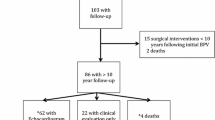Abstract
Radiofrequency perforation and valvuloplasty (RFV) is an effective initial treatment in patients with pulmonary atresia and intact ventricular septum (PA-IVS) and mild to moderate right ventricle and tricuspid valve hypoplasia. Outcomes and risk factors for the need for additional interventions in these patients are poorly defined. All patients with PA-IVS who underwent RFV at our center between January 2000 and July 2011 were reviewed. Twenty-three patients met the inclusion criteria. All patients underwent successful valvuloplasty with no procedural deaths and one major complication. Excluding two patients with limited follow-up, 6 (29 %) patients underwent no subsequent interventions, whereas 9 (42 %) patients underwent surgical right-ventricular outflow tract augmentation. All except one patient with adequate follow-up have a biventricular circulation with saturation >92 %. Patients who did not undergo any right-ventricular outflow tract intervention after valvuloplasty had a significantly lower gradient across the pulmonary valve after valvuloplasty (9.9 mmHg ± 8.4 vs. 19.1 mmHg ± 10.4, p = 0.05). Significantly more patients who received a supplemental source of pulmonary blood flow had a tricuspid valve z-score <−0.7 compared with patients who did not receive supplemental blood flow [2 (15 %) vs. 7 (70 %), p = 0.008]. In our cohort of patients with PA-IVS, radiofrequency perforation with valvuloplasty was an effective and safe first step in establishing a biventricular circulation. Postvalvuloplasty pulmonary valve gradient may be predictive of subsequent outflow tract intervention, and tricuspid hypoplasia may be predictive of the need for a supplemental source of pulmonary blood flow.


Similar content being viewed by others
References
Alwi M (2006) Management algorithm in pulmonary atresia with intact ventricular septum. Catheter Cardiovasc Interv 67:679–686
Alwi M, Geetha K, Bilkis AA, Lim MK, Hasri S, Haifa AL et al (2000) Pulmonary atresia with intact ventricular septum percutaneous radiofrequency-assisted valvotomy and balloon dilation versus surgical valvotomy and Blalock Taussig shunt. J Am Coll Cardiol 35:468–476
Alwi M, Choo KK, Radzi NA, Samion H, Pau KK, Hew CC (2011) Concomitant stenting of the patent ductus arteriosus and radiofrequency valvotomy in pulmonary atresia with intact ventricular septum and intermediate right ventricle: early in-hospital and medium-term outcomes. J Thorac Cardiovasc Surg 141:1355–1361
Chubb H, Pesonen E, Sivasubramanian S, Tibby SM, Simpson JM, Rosenthal E et al (2012) Long-term outcome following catheter valvotomy for pulmonary atresia with intact ventricular septum. J Am Coll Cardiol 59:1468–1476
Daubeney PE, Delany DJ, Anderson RH, Sandor GG, Slavik Z, Keeton BR et al (2002) Pulmonary atresia with intact ventricular septum: range of morphology in a population-based study. J Am Coll Cardiol 39:1670–1679
Hasan BS, Bautista-Hernandez V, McElhinney DB, Salvin J, Laussen PC, Prakash A et al (2013) Outcomes of transcatheter approach for initial treatment of pulmonary atresia with intact ventricular septum. Catheter Cardiovasc Interv 81:111–118
Hirata Y, Chen JM, Quaegebeur JM, Hellenbrand WE, Mosca RS (2007) Pulmonary atresia with intact ventricular septum: limitations of catheter-based intervention. Ann Thorac Surg 84:574–579 discussion 579–580
Humpl T, Soderberg B, McCrindle BW, Nykanen DG, Freedom RM, Williams WG et al (2003) Percutaneous balloon valvotomy in pulmonary atresia with intact ventricular septum: impact on patient care. Circulation 108:826–832
Marasini M, Gorrieri PF, Tuo G, Zannini L, Guido P, Pellegrini M et al (2009) Long-term results of catheter-based treatment of pulmonary atresia and intact ventricular septum. Heart 95:1520–1524
Shaath G, Al Mutairi M, Tamimi O, Alakhfash A, Abolfotouh M, Alhabshan F (2012) Predictors of reintervention in neonates with critical pulmonary stenosis or pulmonary atresia with intact ventricular septum. Catheter Cardiovasc Interv 79:659–664
Author information
Authors and Affiliations
Corresponding author
Rights and permissions
About this article
Cite this article
Schwartz, M.C., Glatz, A.C., Dori, Y. et al. Outcomes and Predictors of Reintervention in Patients With Pulmonary Atresia and Intact Ventricular Septum Treated With Radiofrequency Perforation and Balloon Pulmonary Valvuloplasty. Pediatr Cardiol 35, 22–29 (2014). https://doi.org/10.1007/s00246-013-0733-1
Received:
Accepted:
Published:
Issue Date:
DOI: https://doi.org/10.1007/s00246-013-0733-1




